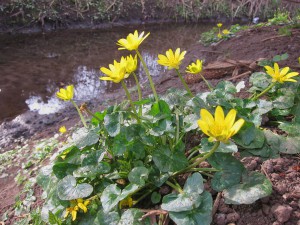The Problem
The Ouse Dyke runs beside the Netherfield Lagoons Local Nature Reserve and historically has attracted kingfishers and herons to fish in it and grey wagtails and green sandpipers to hunt for insects along its banks. The floor of the stream supported a community of water plants and their associated invertebrates and the banks were vegetated with a wide assortment of native plants. Several species of fish, several as fry, were regularly seen in the stream.
Over a series of years Himalayan balsam colonised the banks. The banks were close enough together for the fully grown plants to meet over the top in an arch, cutting out most of the light from the stream bed, with the inevitable result of impoverishing the flora growing in it. The native plants growing on the banks were also out-competed with the result that in winter the banks were bare and lifeless, there was no longer the food to attract some of the birds. The balsam also started to spread away from the stream onto the reserve, especially where the seeds were carried as the Ouse Dyke flooded, which it does on a regular basis.
The Solution
Most of this land belonged to Severn Trent Water and was not the responsibility of the nature reserve owners, but, along the River Trent balsam was growing on reserve land. This was dealt with by pulling, making sure to break off the roots after it was pulled, or by mowing with a brush-cutter, leaving the roots in the ground. Both methods were effective but sites had to be regularly revisited as new seeds would germinate as the light penetrated to them. If all of the plants were dealt with before they could set seed there was very little growing the following year and the plants were eradicated in two years. However new plants arrive along the river banks each spring as the seeds are washed down from further upstream, but this is a small amount compared to what existed before the work started and is soon dealt with.
The Ouse Dyke was a much bigger problem as the balsam grew solidly along more than a mile of its length and large areas of washes on the nature reserve side were also thickly colonised. These washes were dealt with first by cutting with a scythe and pulling. As the first plants were removed light was allowed in and new seeds germinated, so that the process had to be repeated regularly.
The following spring the washes were again targeted but there were far fewer plants and so the Ouse Dyke adjacent to the reserve was also tackled, removing the source of colonisation for the washes.
In the subsequent spring the Ouse Dyke adjacent to the reserve was soon cleared and so up stream and downstream were also dealt with. Fortunately some volunteers came to help and most of the Ouse Dyke was cleared of balsam.
Next spring the Ouse Dyke should be virtually balsam free, except for downstream from the reserve, where it runs through Severn Trent land on both sides.
The Results
In the first spring after the balsam had been removed the submerged plant community in the Ouse Dyke began to develop again. Plants noted included stream water-crowfoot, fennel-leaved pondweed, curled pondweed, spiked water milfoil, Nuttall’s waterweed and water starwort. These plants have collected sediments so that the water moves more slowly over them but forms riffles around them. This provides more habitats for invertebrates and fishes and shoals of minnows are already being seen. The bottom of the stream is no longer flat and featureless and the overall covering of mud now has developed some patches of gravel. The banks are now clothed in green in the winter and hold invertebrates, which supply food for overwintering birds. Where the water plants have trapped sediments they form tiny islands which attract robins, blackbirds, dunnocks, wrens, grey wagtails and meadow pipits to search for food. This winter there were five overwintering Chiffchaffs, all feeding along the Ouse Dyke banks. Little egrets, herons and kingfishers are regularly seen and now the first green sandpiper is avidly being searched for.
